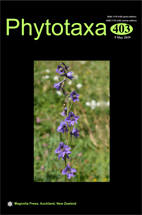Abstract
Two species of Eugenia from the Brazilian Atlantic coastal forest of Bahia and Espírito Santo are here described. Eugenia atlantica is most similar to E. bahiensis from which differs by its leaf blades usually larger, 80–180 × 35–70 mm, and chartaceous, inflorescence mostly axillary, flower buds with hypanthium costate to slightly costate and calyx lobes completely fused or partially fused along two thirds of the bud length. Eugenia soteriana is related with E. zuccarinii but differs mostly by the leaves with two marginal veins, inflorescence fasciculate more often recovering the vegetative growth by an auxotelic axis, bracteoles larger, 2–6 mm long, deciduous after anthesis, and flowers with larger outermost calyx lobes, 1.5–3 mm long. Descriptions, species distribution, habitat, phenology, vernacular names, illustrations, comparisons to other morphologically similar species, and conservation assessments are also provided.

